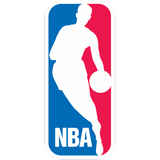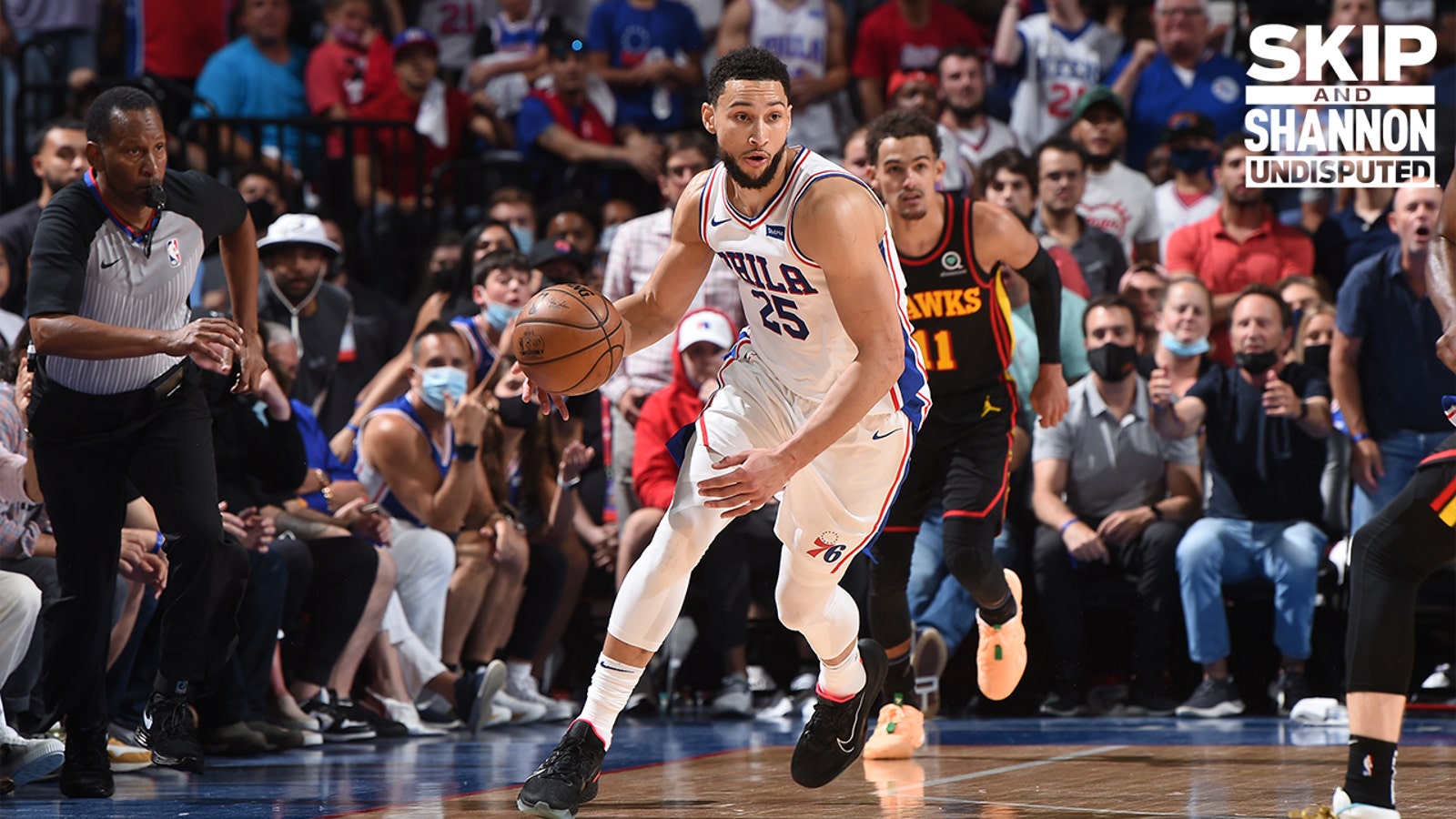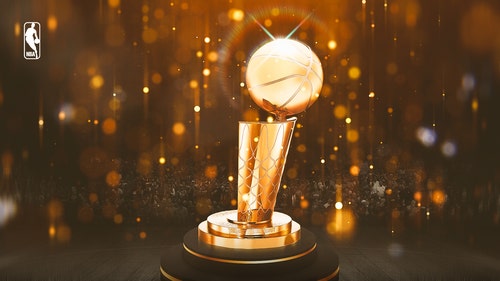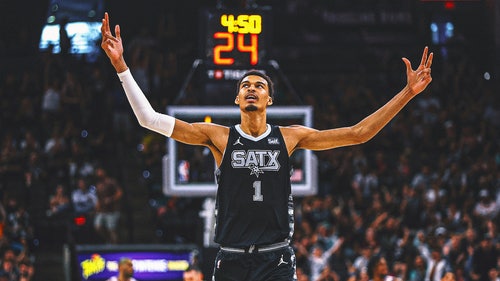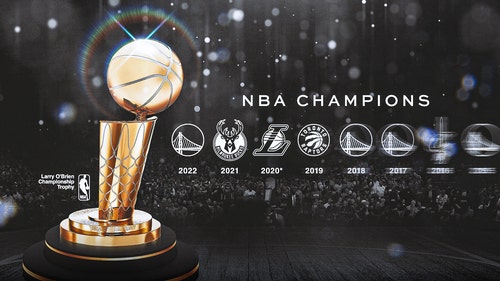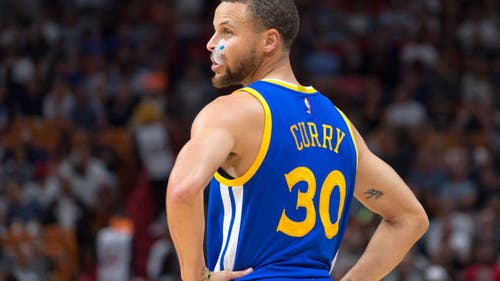
Ben Simmons' playoff struggles create quandary for Philadelphia 76ers
By Yaron Weitzman
FOX Sports NBA Writer
He’d done the hard part already, freeing himself by spinning baseline off the right block.
It was a beautiful move, one of his best and most aggressive of the series, and it had come in crunch time, with just 3:30 remaining in Game 7 and his Philadelphia 76ers trailing the Atlanta Hawks by two.
The Sixers should never have been in this situation. They were the better team, the top seed in the Eastern Conference, and they had worked all season for home-court advantage. If a Game 7 ever did arrive, it would take place on their home floor. It did Sunday night, but the Sixers were still flailing. Two points here, though, could save their season — and maybe his standing with the Sixers.
All Ben Simmons had to do was dunk the ball.
Simmons rose — but then fired the ball into the hands of Matisse Thybulle on the baseline. Thybulle would get fouled and hit only one of two. The Sixers had traded a certain two points for a trip to the free-throw line from a shaky shooter.
Later, Sixers center Joel Embiid would describe that moment as "the turning point of the game."
Philly never did close that gap. A few minutes later, the final buzzer sounded, with the scoreboard reading Hawks 103, Sixers 96. The Sixers walked off the floor of Philadelphia’s Wells Fargo Center to the sound of boos and a smattering of chants calling for Simmons to be traded.
For the third time in four years, the 76ers' season ended in the Eastern Conference semifinals. They haven’t advanced to the conference finals since 2001.
Simmons finished Game 7 with just five points. He finished the playoffs a putrid 25-for-73 from the free-throw line, the worst rate in NBA postseason history. In 56 fourth-quarter minutes across seven games against the Hawks, he took a total of three shots.

All season, Doc Rivers, who took over as Philadelphia's coach after Brett Brown was fired in the summer, had blasted anyone who dared question Simmons’ value.
"I could care less," he told reporters in December when asked about Simmons’ inability to shoot. "I'll let you guys talk about what Ben doesn't do."
After Simmons’ poor free-throw shooting helped the Wizards snatch a game from the Sixers in the first round, Rivers said, "If you guys don’t know the treasure you have by now, then shame on everyone because he has been fantastic for us."
But the missed free throws mounted, and Simmons stopped attacking, and the series against the Hawks lasted longer than it was supposed to, and little by little, Rivers lost confidence in his All-Star point guard.
Sunday night, after the loss, a reporter asked Rivers whether he still believed Simmons could be the starting point of a team with championship aspirations.
"I don’t know the answer to that right now," Rivers replied.
For more up-to-date news on all things Sixers, click here to register for alerts on the FOX Sports app!

Ben Simmons' struggles at the free-throw line have only gotten more pronounced over the course of his NBA career. (Photo by Tim Nwachukwu/Getty Images)
You know, it wasn’t all that long ago that Ben Simmons was bounding up to the foul line during playoff games and burying free throws.
It’s easy to forget, given everything that has happened to both him and the Sixers in the years since. This was back in April 2018, his rookie season and first postseason run, and the Sixers were facing the Miami Heat in the first round. Simmons made seven of his 10 free throws in Game 1, and then he went 4-for-6 in Game 2 and an even better 7-for-8 in Game 3. He struggled in Game 4, going just 1-for-4 from the line, but — in what seemed to be an encouraging sign — responded by going 6-for-7 in the Sixers’ series-clinching Game 5 victory.
Simmons regressed a bit the next round, and the Sixers fell to the Boston Celtics in five games. But this was just Year 1 of the Simmons-Embiid partnership, and they'd already won a playoff series. A better future didn’t just seem probable; it felt guaranteed. Simmons had even approached Embiid after the Sixers’ Game 5 loss to the Celtics, held up his hand and said, "There’s gonna be a lot of [championship] rings on this before we're done."
There were lots of reasons for optimism, and Simmons’ improvement at the line was at the top of the list. Sure, the Celtics had stonewalled him by limiting his transition opportunities and daring him to shoot from the outside. But all that could be fixed. In the meantime, Simmons had hit 70.7% of his free throws in 10 postseason games. He looked confident. His stroke looked smooth.
He’d come a long way, too. Just one year earlier, teammates had spent offseason pick-up games daring him to shoot from the outside, trash-talking him in the process, with Brett Brown, then the team's coach, watching from his office, frustrated and confused. This was a different player than Brown had seen on film, a different player than the one who had no qualms launching an occasional jumper during the 2016 Summer League before he fractured a bone in his left foot, which sidelined him for the entire season.
Simmons spent the year rehabbing and about a year and a half working alongside shooting coach John Townsend. Townsend was hired by Brown in 2016 to work closely with Simmons, and together the two made progress. Maybe not as much as some in the organization would have liked, but still, that 70.6% mark during the postseason represented a massive step forward.
Two days after that 2018 loss to the Celtics, the Sixers held exit meetings in their Camden, New Jersey, training facility. Each player was given a four-page document containing individualized offseason plans. For Simmons, the list of priorities included free-throw shooting, finishing at the rim and developing a jump shot. In that order.
After the meetings, Brown told reporters during a news conference that he expected Simmons to spend "intense time" with Townsend in the offseason. Everyone around the team was excited. They felt like a breakthrough had occurred, that Simmons was ready not only to solidify his improvements at the line but also to begin carrying those changes into his shooting overall.
After exit meetings, the players and coaches went their separate ways to recharge. Some time passed, and according to multiple league sources, when Townsend returned to the team’s facility, Brown pulled him aside. Change of plans, he said.
Simmons’ agent, Rich Paul, and family had decided that he’d be better off working with one of his brothers, Liam, a former low-level Division I guard and assistant coach, who now coaches at Division II Colorado Christian University.
Brown, who'd been promoted to interim GM in the wake of former team president Bryan Colangelo's Twitter scandal, wasn’t sure the reason for the change. It also didn’t matter.
Simmons was a former No. 1 pick, one of the team’s two foundational pieces, a genuine superstar, in talent and branding, in a league in which superstars dictate the terms. In other words: Simmons wasn’t required to explain himself to management.
That season, Simmons’ free-throw shooting regressed once again, plunging back down to 60%, not quite as bad as his rookie-season marks but still a significant drop from his playoff rate. He also took just 25 shots outside of 16 feet after attempting 40 as a rookie. At one point during the year, Jim O’Brien, a longtime NBA coach and former Sixers assistant who was serving as a special adviser to Brown, posed a question during a coaches meeting.
"Name me one area where Ben Simmons has improved," he asked his colleagues.
The room fell silent.
For more up-to-date news on all things Ben Simmons, click here to register for alerts on the FOX Sports app!

Those in Simmons camp are quick to point out that the fourth-year guard is one of the league's best passers and defenders. (Photo by Scott Cunningham/NBAE via Getty Images)
Ben Simmons is a wonderful basketball player.
For one, he might be the best defender in the league. He’s certainly the most versatile. He’s 6-foot-10 and just spent an entire series chasing around — and often locking down — the tiny and electric Trae Young.
He’s also, contrary to what you often hear, a player who generates tons of points for the Sixers' offense. He’s an excellent ball handler, and one of the fastest players in the league, and because he's a good rebounder, he's often a one-man fast break. He’s always among the league leaders in assists. He’s always among the league leaders in how many of his passes create 3-point baskets. He’s always among the leaders in steals and deflections, which lead to turnovers, which lead to points.
You’d be hard-pressed to find many players who do as many things well on the court as Simmons. The problem is the one thing he doesn’t do — shoot or, for that matter, put the ball in the basket from anywhere — happens to be the game’s most essential skill. This has always been the case, but it has become even more true in recent years, as pace and space and 3-point shooting have overtaken the league.
Simmons can’t shoot. He also won’t shoot. The former is a problem, but for the Sixers, the latter has proven crippling. This was the case three years ago against the Celtics, then again the next season against the Raptors and this season against the Hawks. Simmons has played 19 second-round playoff games, with a total of 154 fourth-quarter minutes. In those 154 minutes, he has attempted a total of 20 shots.
It’s not just that he won’t launch 3-pointers or convert freebies at the foul line. It’s that we now have three series’ worth of evidence showing that when he gets past the playoffs’ first round, he’s incapable of contributing on offense. He never has figured out how to transform himself into a half-court weapon, be it as a screener, cutter, roller or some sort of hybrid. This would be an issue for any starter on any team, but Simmons’ insistence on being a point guard makes his limitations even more paralyzing.
According to league sources, Simmons’ frustration at being relegated to off-ball duty during the team’s 2019 second-round loss to the Raptors contributed to the front office’s decision to not re-sign Jimmy Butler. Brown had handed Butler the keys to the offense, and management was worried how Simmons would handle having Butler around and monopolizing crunch-time playmaking duties for multiple years.

Simmons' frustrations visibly mounted during the 2021 playoffs. (Photo by Jesse D. Garrabrant/NBAE via Getty Images)
The next season, prior to the league’s mid-pandemic restart, Brown told reporters that in practices, he’d been playing Simmons "exclusively" at power forward. Management, according to sources, pushed Brown to walk back that proclamation.
"I feel more comfortable bringing the ball up," Simmons told me in the summer of 2017. "I feel limited if you put me at the 4 position. I don't feel I can help as much."
The Sixers deserve credit for trying to plug some of these holes by drafting Markelle Fultz in 2017. Like so much else that has happened to this franchise in the years since, it’s hard not to look back at that selection and wonder what things would look like in Philadelphia if Fultz had become the player most thought he’d be.
So here they are, in a league governed by a salary cap, paying the max to a point guard who can’t actually play point guard when the games matter most, forcing them to run their late-game offense against the Hawks through a shooter with limited playmaking skills such as Seth Curry. It’s not that Simmons is solely responsible for all the Sixers’ recent flameouts, but at a certain point, you start to wonder if the scales have tipped from him helping to hurting.
It was December 2019 when Simmons made internet headlines for doing something he almost never does. He took, and made, a 3-pointer. The crowd, and Sixers bench, went wild.
After the game, Brown was asked by a reporter what he thought. "You can pass this along to his agent, his family, his friends and him," Brown said. "I want one 3-point shot a game, minimum."
Six weeks later, Simmons was sitting in the visitor’s locker room at Barclays Center, preparing for a game against the Nets. He hadn’t launched a 3-pointer since Brown’s comments, and I was curious why. So I approached him and asked if I could ask him a few questions.
"What about?" he asked.
"Shooting," I told him.
"Are they good questions?"
I told him I thought so.
He offered a half-smile. I’d written a number of profiles on Simmons over the years, and my book on the Sixers and The Process would be out soon. He and I weren’t close or anything, but my face was familiar. He was willing to have a real conversation.
"Why don’t you want to shoot more?" I asked him.
"I mean, I take my shots. I get shots up," he replied. "I think it’s just finding a balance of when to shoot and when to take certain shots."
"But when you hear people say that for court spacing with Joel just being willing to take a corner 3," I began replying, but Simmons cut me off.
"Our offense isn’t designed for that," he said. "There’s things I need to work on, which I’m going to do, but I think the way I play, my style, I’m able to create things. I’m a creative player, I make things happen, which 90 percent of the league can’t do. There’s only a select few players who can make plays and get guys good shots."
"You get what I’m saying, though."
"I hear what you’re saying, but at the same time, like, I don’t sit here and say, like, ‘I gotta do this every time.’ My game’s not based off that. Like, I do so many things on the court where I’m efficient and effective, affecting the game in different ways, so there’s things I need to work on, but, I mean, if you really want, you can look at other players and be like, ‘Well, this guy needs to work on his dribbling because he can’t dribble. He has this many turnovers if he’s forced to dribble.’"
"But let’s stick with something like a corner 3. I’ve seen you shoot that and hit it in practice."
"I think it’s also just getting the best shot we can every time, and that’s my main focus, really, just try to get the best shot we can."
"OK, but say Joel has the ball on the block. You can either space to the corner or go to the dunker spot."
"Which corner? The weak-side corner?"
"Yeah."
"I mean, that’s a tough pass. If you count the amount of times that Jo’s going to throw that, it’s not too many. And it’s not really me saying he’s a selfish player. It’s me saying that if I’m in a better position to rebound the ball knowing he’s going to take the shot, then I’d rather be there. Like, if my man goes to double, then I’m going to go under the rim, and Joe’s going to pass it. If my man stays, he has a one-on-one."
Simmons scored 34 points that night, leading the Sixers to a six-point victory. He conducted his postgame news conference from the locker room, and after, as he walked toward the door, he stopped and turned to me.
"Imagine if I hit those corner 3s," he said.

The All-Star tandem of Joel Embiid and Simmons was supposed to deliver Philly its first NBA title in nearly four decades. (Photo by Jesse D. Garrabrant/NBAE via Getty Images)
Ben Simmons was groomed for stardom.
It’s important to remember this if you want to understand how he has arrived at the point he is today.
He left his native Australia as a 15-year-old boy so that he could play for powerhouse Montverde Academy, coming to Florida by himself.
"It was pretty tough on him," one of his brothers, Sean, once told me. Simmons missed his home. He missed his family. He missed friends. But even as a teenager, he was singularly focused, and while it might have been more nurture than nature, he was willing to push all his other emotions aside so that he could chase his goal.
"I remember talking to him about a year-and-a-half in and asking him, ‘Are you still homesick?’" his sister Olivia told me in 2016. "And he said, ‘Yeah, but you know, this is where I need to be in order to get where I want to go.’"
The decision paid off. He got invited to summer workouts with LeBron James and Dwyane Wade. He became the top prospect in his class.
This was also the start of the social media age, and the spotlight came with increased scrutiny, one that most high school stars who came along before never had to face.
Simmons’ embraced that reality, even having a documentary crew follow him around during his lone season at LSU — where he enrolled largely because his godfather, David Patrick, was an assistant coach — but his life was more akin to those of child stars such as Justin Bieber than basketball prospects such as Karl-Anthony Towns.
That chasing of stardom came with consequences. Keith Hornsby, an LSU teammate and roommate, told me in 2016 that, "Some people couldn’t handle that Ben was always the one getting credit. It wasn’t Ben’s fault; it was just hard with all the media attention."
NBA executives told draft expert Jonathan Givony they thought Simmons had a character problem. An introvert by nature, Simmons responded by turning more inward, cutting his circle down to family and the closest of friends. His parents moved to Philadelphia. Sean became his manager. Klutch Sports, where one of his sisters worked, became his agency.
Everything was going according to plan. He became the No. 1 pick. He recorded 18 points, 10 rebounds and five assists in his NBA debut and afterward said, "I felt like I was playing [NBA]2K." Three games later, he recorded a triple-double. He told Patrick "the game in the NBA was easier for him to control than in college." He won Rookie of the Year. Since then, he has become a three-time All-Star and signed a max contract. The Sixers have transformed into a perennial contender.
He did things his way and listened to his people, and it all worked out. But now we’re seeing the consequences. What happens when suddenly the game doesn’t feel like NBA2K? How do you solve a problem if you’ve never been willing to confront it?
For years, Simmons’ reluctance to shoot baffled the Sixers. Early in his career, he’d goof around when coaches, including Brown, worked with him, sometimes flippantly launching the ball high into the air while practicing free throws instead of attempting a normal shot. He'd leave immediately after a practice without putting in extra time. But as time went by, current and former Sixers staffers say, those habits changed.
The work wasn’t the problem, which only confounded Sixers coaches and management even more. Brown would hurl curses at Townsend, asking why Simmons wasn’t shooting in the games, and try utilizing every teaching tool in his kit, all to no avail.
Monty Williams, who worked closely with Simmons while serving as an assistant to Brown for one season, hypothesized to friends that Simmons was scared of looking bad. Management under Colangelo even discussed having Simmons switch his shooting hand from left to right, which serves as his dominant hand in every other facet of his life.
None of it worked. The more anyone pushed, the more Simmons pushed back, creating a self-fulfilling cycle. Simmons told multiple Sixers staffers that because he was a poor shooter, he figured the team would be better off with him trying to drive and kick. Which in theory is fine — his 3-point shot is never going to scare defenses into guarding out on the perimeter — but against the Hawks he did neither.
Late in Game 6, rookie point guard Tyrese Maxey brought the ball across half court and dribbled to the left wing. He wanted to get the ball to Embiid on the left block. Embiid was blanketed by his man but also Danilo Gallinari, who had shaded off Simmons to help. The gambit had left Simmons open on the right elbow; all he needed to do was open to Maxey, catch the ball and pivot toward the hoop. From there, he could hit Embiid with a high-low pass or even take a dribble and attack the hoop. Instead he stood still, pointing to Seth Curry along the perimeter.
For more up-to-date news on all things NBA, click here to register for alerts on the FOX Sports app!

Sixers coach Doc Rivers defended Simmons all season, but he was vague about the 24-year-old's future Sunday night. (Photo by Tim Nwachukwu/Getty Images)
It’s hard to read how Simmons is processing all this.
After Game 5, when the Sixers blew a 26-point, second-half lead and Simmons went 4-for-14 from the line and was pulled by Rivers in crunch time, he told reporters that he believed his issues were "definitely, I think, mental."
The comment was a far cry from him describing the NBA as "easy." It was the most vulnerability he has ever publicly displayed. He sounded broken, and it was understandable why. He’d entered the year with so much optimism. He was excited to play for a new coach and clicked with him over the course of the season.
Rivers was tough but caring. He’d call out stars for mistakes one night, then pick up the team’s dinner tab the next. And he was vociferous in his defense of Simmons, highlighting the things Simmons does excel at — defense and passing — the same way Simmons does.
Then came Game 7. During his postgame news conference one reporter asked Simmons why his performance in the playoffs always seems to drop. Simmons turned to a Sixers staffer seated alongside him.
"How many assists I have?" he asked. The answer was 13. He turned back to the Zoom screen. "I mean, I feel like I found my guys tonight, which I do in the regular season regardless," he said.
He then turned to the staffer again.
"What did Trae shoot?" he asked. The answer was 5-for-23.
It was a revealing moment, a window into how he feels. People around Simmons put it this way: He’s a 24-year-old perennial Defensive Player of the Year candidate. One of the league’s premier passers. An engine for a perennial Eastern Conference powerhouse. All while being the rare No. 1 pick to play on a roster not built around that player’s strengths. Yet he gets no leeway.
Most young stars endure growing pains before becoming piñatas. They’re allowed to lose in the playoffs before the critics descend. Simmons feels he was never given this chance.
Not only that, but when something goes wrong with the Sixers, it’s usually Simmons who gets the blame. And there’s some validity to that. But it’s also clear that his limitations have Rivers and, going by some of his postgame comments, perhaps Embiid ready to move on. We know Sixers president of basketball operations Daryl Morey tried trading Simmons for James Harden in the winter.
"Ben Simmons became unplayable. It might be time for the 76ers to cut their losses" — Shannon Sharpe on Philly's GM 7 loss to Hawks | UNDISPUTED
He won’t get that sort of return for Simmons anywhere, but would he be willing to go down a level or two and try fetching fringe stars such as CJ McCollum or Malcolm Brogdon?
Simmons has faced criticism before, but nothing like what he’s experiencing right now. There’s no longer anyone on the Sixers protecting him. Will he respond by turning further inward, or will he finally confront his limitations head-on?
Yaron Weitzman is an NBA writer for FOX Sports and the author of Tanking to the Top: The Philadelphia 76ers and the Most Audacious Process in the History of Professional Sports. Follow him on Twitter @YaronWeitzman.
